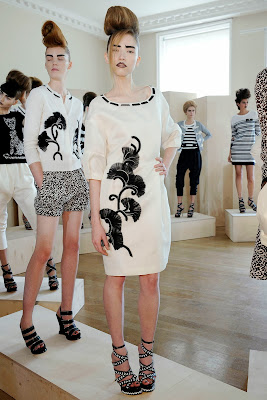'innovative, eccentric, colourful'
The brand 'Moschino' was founded in 1983 by Franco Moschino in Milan. He first started in the fashion industry by illustrating designs for Gianni Versace. Since opening his first store, his work has been known to criticize the fashion industry. With garments like the embellsihed jacket that had "expensive jacket" written on; generated popularity for the brand and established Moschino as a designer.
Moschino once declared he was 'not a fashion designer. I am a painter, a decorator. I am not the author of a new era.' Although Moschino did not perceive himself as a fashion designer it is clear that critics thought otherwise. He introduced new eclectic ideas for the industry, mainly based upon insults. However people warmed to the tongue and cheek his brand was known for.
In 1988 Moschino introduced a new line as part of the company, 'Moschino Cheap and Chic.' Another bold move by the designer, which proved successful as it satisfied other consumers.
Moschino Cheap and Chic S/S 2012
Detailing of crochet design onto soft knitwear.The colour tones of the dusty pink, olive green and cream keep the look fresh, and understated.
In 1994, what unfortunately turned out to be Moschino's last collection was his introduction of 'Ecouture' capsule line. The garments were made with resourceful materials and labelled, 'Nature Friendly Garment.' Later that year Franco Moschino passed away on September 18th. Rossella Jardini, who worked closely with the designer, continued with the company as Creative Director. She later stated that 'Franco raised the designers who worked under him; he had faith in them and gave them creative freedom.'
Moschino's label did create ironic and surrealist impressions of the fashion industry. However many of his designs have become remarkable success, proving his tailoring skills were as strong as other influential designers.
Rossella Jardini has recently left the company after almost twenty years of dedicated, and beautiful designs that embody Franco Moschino's eccentric take on fashion. Jeremy Scott is now the new creative director, with his first collection for the brand premiering A/W 2014. A spokeswoman from the company stated, 'This appointment respects the DNA of the brand as Jeremy Scott represents not only an eclectic and contemporary communicator but most of all a designer capable of re-interpreting the identity and the essence of Moschino.'
Moschino S/S 14
The label does not disappoint with Rossella Jardini's final collection for the brand. Embodying true Moschino tongue and cheek style, with teddy bear accessories to 'Holy Chic' statements. The collection is outragous, eclectic and fun, with the models dancing down the catwalk to Gloria Gaynor's 'I am What I am'.
In 1994, what unfortunately turned out to be Moschino's last collection was his introduction of 'Ecouture' capsule line. The garments were made with resourceful materials and labelled, 'Nature Friendly Garment.' Later that year Franco Moschino passed away on September 18th. Rossella Jardini, who worked closely with the designer, continued with the company as Creative Director. She later stated that 'Franco raised the designers who worked under him; he had faith in them and gave them creative freedom.'
Moschino's label did create ironic and surrealist impressions of the fashion industry. However many of his designs have become remarkable success, proving his tailoring skills were as strong as other influential designers.
Rossella Jardini has recently left the company after almost twenty years of dedicated, and beautiful designs that embody Franco Moschino's eccentric take on fashion. Jeremy Scott is now the new creative director, with his first collection for the brand premiering A/W 2014. A spokeswoman from the company stated, 'This appointment respects the DNA of the brand as Jeremy Scott represents not only an eclectic and contemporary communicator but most of all a designer capable of re-interpreting the identity and the essence of Moschino.'
Moschino S/S 14
The label does not disappoint with Rossella Jardini's final collection for the brand. Embodying true Moschino tongue and cheek style, with teddy bear accessories to 'Holy Chic' statements. The collection is outragous, eclectic and fun, with the models dancing down the catwalk to Gloria Gaynor's 'I am What I am'.




























